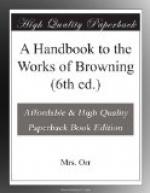“PAN AND LUNA” describes a mythical adventure of Luna—the moon, given by Virgil in the Georgics; and has for its text a line from them (III. 390):
“Si credere dignum est."[108]
According to the legend, Luna was one night entrapped by Pan who lay in wait for her in the form of a cloud, soft and snowy as the fleece of a certain breed of sheep; and, Virgil continues, followed him to the woodland, “by no means spurning him.” But Mr. Browning tells the story in a manner more consonant with the traditional modesty of the “Girl-Moon.” She was, he says, distressed by the exposure of her full-orbed charms, as she flew bare through the vault of heaven: the protecting darkness ever vanishing before her; and she took refuge for concealment in the cloud of which the fleecy billows were to close and contract about her, in the limbs of the goat-god. How little she accepted this her first eclipse, may be shown, he thinks, by the fact that she never now lingers within a cloud longer than is necessary to “rip” it through.
“JOCOSERIA.”
The volume so christened (grave and gay), published 1883, shows a greater variety of subject and treatment than do the Dramatic Idyls, and its contents might be still more easily broken up; but they are also best given in their original form. They are—
“Wanting is—what?”
“Donald.”
“Solomon and Balkis.”
“Cristina and
Monaldeschi.”
“Mary Wollstonecraft
and Fuseli.”
“Adam, Lilith,
and Eve.”
“Ixion.”
“Jochanan Hakkadosh.”
“Never the Time
and the Place.”
“Pambo.”
“WANTING IS—WHAT?” is an invocation to Love, as the necessary supplement to whatever is beautiful in life. It may equally be addressed to the spirit of Love, or to its realization in the form of a beloved person.




